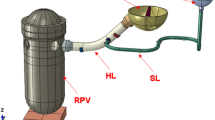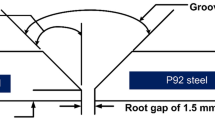Abstract
The target of EU FP7 STYLE project “Structural integrity for lifetime management – non-RPV component” was to improve and unify the methods of a structural integrity assessment in the ageing and lifetime management of reactor coolant pressure boundary components. One of the mock-ups in the project was manufactures from two pipes welded together. After completion of the girth weld, a deep weld repair was inserted into the girth weld. As a part of the work, round-robin finite element computations were performed to determine residual stresses after repair welding and the computational results were compared to the deep hole drilling measurements. In this paper, the details and recomputed results of one of the analyses is presented. A part of the input data was generated with in-house codes. Sequential thermal and mechanical analyses were performed with a small strain and displacement formulation. The comparison of computed and measured temperatures and stresses shows good agreement. The computed hoop stress at the repair mid-length was higher than the axial stress. Both stresses were tensile through the wall thickness. Confidence in the results was also gained as the results were compared to those presented in the literature for a repair welding case.

















Similar content being viewed by others
References
Smith MC, Muransky O, Smith D, Do SC, Bouchard PJ, Mathew J (2014) Modelling and measuring residual stresses in pipe girth welds: lessons from the Style Framework 7 project. Proceedings of the ASME 2014 Pressure Vessels and Piping Conference, Anaheim, pp 20–24
Keinänen H (2013) Weld repair simulation for the Mock-up 2 of EU FP7 STYLE project. Baltica IX, International Conference on Life Management and Maintenance for Power Plants, Helsinki–Stockholm–Helsinki p11–13
Smith MC, Bourgeois M, Arun S, Do SC, Kayser Y, Smith D, Sherry A (2014) Understanding the impact of high-magnitude repair-weld residual stresses on ductile crack initiation and growth—the STYLE Mock-up 2 large scale test. Proceedings of the ASME 2014 Pressure Vessels and Piping Conference, USA, pp 20–24
Bézi Z, Szávai S (2014) Repair weld simulation of austenitic steel pipe. Advanced Materials Research 1029:194–199
STYLE Mock-up 2 finite element simulation protocol (2011) Prepared by Smith MC. Project internal report, Issue 1
Abaqus Theory Manual, version 6.11-1. Dassault Systemes, 2011
Computation of welding residual stresses in a multi-pass welded mock-up pipe. Keinanen, H. 22nd International Conference on Structural Mechanics in Reactor Technology, San Francisco. p 18–23
Armstrong PJ, Frederick CO (1966) A mathematical representation of the multiaxial Bauschinger effect, C.E.G.B. Report RD/B/ N731, Berkeley Nuclear Laboratories, Berkeley, UK
Chaboche JL (1989) Constitutive equations for cyclic plasticity and cyclic viscoplasticity. Int J Plasticity 5:247–302
Elcoate CD, Dennis RJ, Bouchard PJ, Smith MC (2005) Three dimensional multi-pass repair weld simulations. Int J Pres Ves Pip 82:244–257
Acknowledgments
This work was a part of the EU granted project “Structural integrity for lifetime management – non-RPV components (STYLE)”. In addition to EU, this work was also partly funded by VTT Technical Research Centre of Finland Ltd. The work was a part of the Work Package 2.2 of the STYLE project (2010–2013). The primary objective of the WP2.2 simulation round robin was to provide accurate predictions of weld residual stresses concerning a mock-up and to compare the computational and experimental results against each other.
Author information
Authors and Affiliations
Corresponding author
Additional information
Recommended for publication by Commission X - Structural Performances of Welded Joints - Fracture Avoidance
Rights and permissions
About this article
Cite this article
Keinänen, H. Computation of residual stresses for a repair weld case. Weld World 60, 507–513 (2016). https://doi.org/10.1007/s40194-016-0323-y
Received:
Accepted:
Published:
Issue Date:
DOI: https://doi.org/10.1007/s40194-016-0323-y




